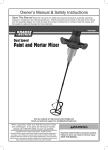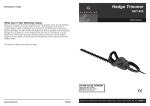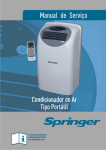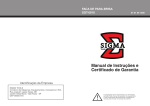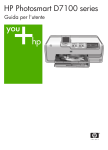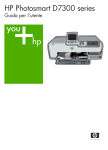Download Harbor Freight Tools 3/8 in. Belt Air Sander Product manual
Transcript
Table of contents Safety ......................................................... 2 Maintenance .............................................. 12 Specifications ............................................. 6 Parts List and Diagram .............................. 14 Setup .......................................................... 7 Warranty .................................................... 16 SAFETy Operation ................................................... 10 WARNING SyMBOLS AND DEFINITIONS This is the safety alert symbol. It is used to alert you to potential personal injury hazards. Obey all safety messages that follow this symbol to avoid possible injury or death. SETUp Indicates a hazardous situation which, if not avoided, will result in death or serious injury. Indicates a hazardous situation which, if not avoided, could result in death or serious injury. Indicates a hazardous situation which, if not avoided, could result in minor or moderate injury. Addresses practices not related to personal injury. OpERATION IMpORTANT SAFETy INSTRUcTIONS INSTRUcTIONS pERTAINING TO A RISK OF FIRE, ELEcTRIc SHOcK, OR INJURy TO pERSONS WARNING – When using tools, basic precautions should always be followed, including the following: General To reduce the risks of electric shock, fire, and injury to persons, read all the instructions before using the tool. MAINTENANcE Work Area 1. Keep the work area clean and well lighted. Cluttered benches and dark areas increase the risks of electric shock, fire, and injury to persons. 3. Keep bystanders, children, and visitors away while operating the tool. Distractions are able to result in the loss of control of the tool. 2. Do not operate the tool in explosive atmospheres, such as in the presence of flammable liquids, gases, or dust. The tool is able to create sparks resulting in the ignition of the dust or fumes. Page 2 For technical questions, please call 1-800-444-3353. Item 60627 2. Dress properly. Do not wear loose clothing or jewelry. contain long hair. Keep hair, clothing, and gloves away from moving parts. Loose clothes, jewelry, or long hair increases the risk of injury to persons as a result of being caught in moving parts. 3. Avoid unintentional starting. Be sure the switch is off before connecting to the air supply. Do not carry the tool with your finger on the switch or connect the tool to the air supply with the switch on. 4. Remove adjusting keys and wrenches before turning the tool on. A wrench or a key that is left attached to a rotating part of the tool increases the risk of personal injury. 5. Do not overreach. Keep proper footing and balance at all times. Proper footing and balance enables better control of the tool in unexpected situations. 6. Use safety equipment. A dust mask, non-skid safety shoes and a hard hat must be used for the applicable conditions. 7. Always wear eye protection. Wear ANSI-approved safety goggles. 8. Always wear hearing protection when using the tool. Prolonged exposure to high intensity noise is able to cause hearing loss. SETUp 1. Stay alert. Watch what you are doing and use common sense when operating the tool. Do not use the tool while tired or under the influence of drugs, alcohol, or medication. A moment of inattention while operating the tool increases the risk of injury to persons. SAFETy personal Safety Tool Use and care 2. Do not force the tool. Use the correct tool for the application. The correct tool will do the job better and safer at the rate for which the tool is designed. 3. Do not use the tool if the switch does not turn the tool on or off. Any tool that cannot be controlled with the switch is dangerous and must be repaired. 4. Disconnect the tool from the air source before making any adjustments, changing accessories, or storing the tool. Such preventive safety measures reduce the risk of starting the tool unintentionally. Turn off and detach the air supply, safely discharge any residual air pressure, and release the throttle and/or turn the switch to its off position before leaving the work area. 5. Store the tool when it is idle out of reach of children and other untrained persons. A tool is dangerous in the hands of untrained users. 6. Maintain the tool with care. A properly maintained tool reduces the risk of binding and is easier to control. 7. check for misalignment or binding of moving parts, breakage of parts, and any other condition that affects the tool's operation. If damaged, have the tool serviced before using. Many accidents are caused by poorly maintained tools. There is a risk of bursting if the tool is damaged. 8. Use only accessories that are identified by the manufacturer for the specific tool model. Use of an accessory not intended for use with the specific tool model, increases the risk of injury to persons. MAINTENANcE Service 1. Tool service must be performed only by qualified repair personnel. 3. Use only the lubricants supplied with the tool or specified by the manufacturer. 2. When servicing a tool, use only identical replacement parts. Use only authorized parts. Item 60627 OpERATION 1. Use clamps or another practical way to secure and support the workpiece to a stable platform. Holding the work by hand or against the body is unstable and is able to lead to loss of control. For technical questions, please call 1-800-444-3353. Page 3 Air Source 1. SAFETy Never connect to an air source that is capable of exceeding 200 psi. Over pressurizing the tool may cause bursting, abnormal operation, breakage of the tool or serious injury to persons. Use only clean, dry, regulated compressed air at the rated pressure or within the rated pressure range as marked on the tool. Always verify prior to using the tool that the air source has been adjusted to the rated air pressure or within the rated air-pressure range. 2. Never use oxygen, carbon dioxide, combustible gases or any bottled gas as an air source for the tool. Such gases are capable of explosion and serious injury to persons. SAVE THESE INSTRUcTIONS. Symbols and Specific Safety Instructions SETUp Symbol Definitions Symbol no .../min property or statement Symbol property or statement No-load speed NpT National pipe thread, tapered Revolutions or reciprocation per minute NpS National pipe thread, straight OpERATION pSI Pounds per square inch of pressure ft-lb Foot-pounds of torque BpM Blows per minute cFM Cubic Feet per Minute flow ScFM Cubic Feet per Minute flow at standard conditions WARNING marking concerning Risk of Eye Injury. Wear ANSI-approved eye protection. WARNING marking concerning Risk of Hearing Loss. Wear hearing protection. WARNING marking concerning Risk of Respiratory Injury. Wear NIOSH-approved dust mask/respirator. WARNING marking concerning Risk of Explosion. MAINTENANcE Page 4 For technical questions, please call 1-800-444-3353. Item 60627 2. WARNING: Some dust created by power sanding, sawing, grinding, drilling, and other construction activities, contains chemicals known [to the State of California] to cause cancer, birth defects or other reproductive harm. Some examples of these chemicals are: • Lead from lead-based paints • Crystalline silica from bricks and cement or other masonry products • Arsenic and chromium from chemically treated lumber Your risk from these exposures varies, depending on how often you do this type of work. To reduce your exposure to these chemicals: work in a well ventilated area, and work with approved safety equipment, such as those dust masks that are specially designed to filter out microscopic particles. (California Health & Safety Code § 25249.5, et seq.) 3. WARNING: The brass components of this product contain lead, a chemical known to the State of California to cause birth defects (or other reproductive harm). (California Health & Safety code § 25249.5, et seq.) 4. Attach all accessories properly to the tool before connecting the air supply. A loose accessory may detach or break during operation. 5. Obey the manual for the air compressor used to power this tool. 6. Install an in-line shutoff valve to allow immediate control over the air supply in an emergency, even if a hose is ruptured. 7. Use this tool with both hands only. Using tools with only one hand can result in loss of control. 8. Do not lay the tool down until it has come to a complete stop. Moving parts can grab the surface and pull the tool out of your control. SETUp 1. The warnings and precautions discussed in this manual cannot cover all possible conditions and situations that may occur. It must be understood by the operator that common sense and caution are factors which cannot be built into this product, but must be supplied by the operator. SAFETy Specific Safety Instructions Vibration precautions 1. Anyone using vibrating tools regularly or for an extended period should first be examined by a doctor and then have regular medical check-ups to ensure medical problems are not being caused or worsened from use. Pregnant women or people who have impaired blood circulation to the hand, past hand injuries, nervous system disorders, diabetes, or Raynaud's Disease should not use this tool. If you feel any symptoms related to vibration (such as tingling, numbness, and white or blue fingers), seek medical advice as soon as possible. 2. Do not smoke during use. Nicotine reduces the blood supply to the hands and fingers, increasing the risk of vibration-related injury. 3. Wear suitable gloves to reduce the vibration effects on the user. 4. Use tools with the lowest vibration when there is a choice. 5. Include vibration-free periods each day of work. 6. Grip tool as lightly as possible (while still keeping safe control of it). Let the tool do the work. OpERATION This tool vibrates during use. Repeated or long-term exposure to vibration may cause temporary or permanent physical injury, particularly to the hands, arms and shoulders. To reduce the risk of vibration-related injury: 7. To reduce vibration, maintain tool as explained in this manual. If abnormal vibration occurs, stop immediately. MAINTENANcE SAVE THESE INSTRUcTIONS. Item 60627 For technical questions, please call 1-800-444-3353. Page 5 Functional Description Specifications SAFETy Maximum Air Pressure 90 PSI Air Inlet 1/4″ -18 NPT Average Air Consumption 7 CFM @ 90 PSI Belt Size 13″ x 3/8″ components and controls SETUp Throttle Lever Belt position cap Screw OpERATION Sanding Belt Belt Tension Latch Belt Arm MAINTENANcE Page 6 For technical questions, please call 1-800-444-3353. Item 60627 Initial Tool Set Up/Assembly Note: For additional information regarding the parts listed in the following pages, refer to the Assembly Diagram near the end of this manual. Note: This air tool may be shipped with a protective plug covering the air inlet. Remove this plug before set up. SAFETy Read the ENTIRE IMpORTANT SAFETy INFORMATION section at the beginning of this manual including all text under subheadings therein before set up or use of this product. Air Supply 2. Attach an air hose to the compressor's air outlet. Connect the air hose to the air inlet of the tool. Other components, such as a coupler plug and quick coupler, will make operation more efficient, but are not required. WARNING! TO pREVENT SERIOUS INJURy FROM AccIDENTAL OpERATION: Do not install a female quick coupler on the tool. Such a coupler contains an air valve that will allow the air tool to retain pressure and operate accidentally after the air supply is disconnected. Note: Air flow, and therefore tool performance, can be hindered by undersized air supply components. The air hose must be long enough to reach the work area with enough extra length to allow free movement while working. 4. Close the in-line shutoff valve between the compressor and the tool. 5. Turn on the air compressor according to the manufacturer's directions and allow it to build up pressure until it cycles off. 6. Adjust the air compressor's output regulator so that the air output is enough to properly power the tool, but the output will not exceed the tool's maximum air pressure at any time. Adjust the pressure gradually, while checking the air output gauge to set the right pressure range. 7. Inspect the air connections for leaks. Repair any leaks found. 8. If the tool will not be used at this time, turn off and detach the air supply, safely discharge any residual air pressure, and release the throttle and/or turn the switch to its off position to prevent accidental operation. Note: Residual air pressure should not be present after the tool is disconnected from the air supply. However, it is a good safety measure to attempt to discharge the tool in a safe fashion after disconnecting to ensure that the tool is disconnected and not powered. For technical questions, please call 1-800-444-3353. MAINTENANcE 3. Turn the tool's throttle or switch to the off position; refer to Operation section for description of controls. Item 60627 OpERATION 1. Incorporate a filter, regulator with pressure gauge, in-line shutoff valve, and quick coupler for best service, as shown on Figure A on page 8 and Figure B on page 9. An in-line shutoff ball valve is an important safety device because it controls the air supply even if the air hose is ruptured. The shutoff valve should be a ball valve because it can be closed quickly. SETUp TO pREVENT SERIOUS INJURy FROM EXpLOSION: Use only clean, dry, regulated, compressed air to power this tool. Do not use oxygen, carbon dioxide, combustible gases, or any other bottled gas as a power source for this tool. Page 7 Description Non-lubricated Tools A Air Hose Filter Regulator Lubricator (optional) Coupler and Plug Leader Hose (optional) Air Cleaner / Dryer (optional) Air Adjusting Valve (optional) MAINTENANcE A B C D E F G H OpERATION Lubricated Tools B B C C A A E E F H Connects air to tool Prevents dirt and condensation from damaging tool or workpiece Adjusts air pressure to tool For air tool lubrication Provides quick connection and release Increases coupler life Prevents water vapor from damaging workpiece For fine tuning airflow at tool G D Function SETUp Figure A: portable Air Supply Setup SAFETy Page 8 For technical questions, please call 1-800-444-3353. Item 60627 Item 60627 For technical questions, please call 1-800-444-3353. Page 9 A B C D E F G H I J K L M N O F Description F E I I J K N OpERATION J H SETUp Function H L L M O SAFETy For noise and vibration reduction Secures air compressor in place Isolates sections of system for maintenance For vibration reduction Distributes air to branch lines To drain moisture from system Brings air to point of use Connects air to tool Prevents dirt and condensation from damaging tool or workpiece Adjusts air pressure to tool For air tool lubrication Provides quick connection and release Increases coupler life Prevents water vapor from damaging workpiece For fine tuning airflow at tool Non-lubricated Tools C C Vibration Pads Anchor Bolts Ball Valve Isolation Hose Main Air Line - 3/4″ minimum recommended Ball Valve Branch Air Line -1/2″ minimum recommended Air Hose Filter Regulator Lubricator (optional) Coupler and Plug Leader Hose (optional) Air Cleaner / Dryer (optional) Air Adjusting Valve (optional) B A MAINTENANcE B A C D G Lubricated Tools Slope Figure B: Stationary Air Supply Setup F Operating Instructions Read the ENTIRE IMpORTANT SAFETy INFORMATION section at the beginning of this manual including all text under subheadings therein before set up or use of this product. SAFETy Inspect tool before use, looking for damaged, loose, and missing parts. If any problems are found, do not use tool until repaired. TOOL SET Up TO pREVENT SERIOUS INJURy FROM AccIDENTAL OpERATION: Turn off the tool, detach the air supply, safely discharge any residual air pressure in the tool, and release the throttle before performing any inspection, maintenance, or cleaning procedures. TO pREVENT SERIOUS INJURy: Do not adjust or tamper with any control or component in a way not specifically explained within this manual. Improper adjustment can result in tool failure or other serious hazards. SETUp Attaching Sanding Belt 1. Press back on the end of the Belt Arm until the Belt Tension Latch engages. 3. Place a new Sanding Belt on the Belt Arm and align it with the pulleys. 2. Remove the old Sanding Belt. 4. Press the Belt Tension Latch to secure the Sanding Belt. Make sure the Belt is properly aligned on the pulleys. OpERATION Setting Belt Angle 1. Loosen the Belt Position Cap Screw. 3. Tighten the Belt Position Cap Screw. 2. Rotate the Sanding Belt to the desired position. cAUTION! Do not position the belt where it might contact your hand during use. MAINTENANcE Page 10 For technical questions, please call 1-800-444-3353. Item 60627 Workpiece and Work Area Set Up 2. Route the air hose along a safe route to reach the work area without creating a tripping hazard or exposing the air hose to possible damage. The air hose must be long enough to reach the work area with enough extra length to allow free movement while working. 3. Secure loose workpieces using a vise or clamps (not included) to prevent movement while working. 4. There must not be hazardous objects (such as utility lines or foreign objects) nearby that will present a hazard while working. SAFETy 1. Designate a work area that is clean and well-lit. The work area must not allow access by children or pets to prevent distraction and injury. 2. Place the rotating Sanding Belt on the workpiece surface. Move the Sander back and forth to remove material. 3. Keep light pressure on the Sander when in use. To avoid damaging the work surface, do not apply heavy pressure. 4. If the tool requires more force to accomplish the task, verify that the tool receives sufficient, unobstructed airflow (CFM) and increase the pressure (PSI) output of the regulator up to the maximum air pressure rating of this tool. cAUTION! TO pREVENT INJURy FROM TOOL OR AccESSORy FAILURE: Do not exceed the tool's maximum air pressure rating. If the tool still does not have sufficient force at maximum pressure and sufficient airflow, then a larger tool may be required. MAINTENANcE 5. To prevent accidents, turn off the tool, detach the air supply, safely discharge any residual air pressure in the tool, and release the throttle after use. Clean external surfaces of the tool with clean, dry cloth, and apply a thin coat of tool oil. Then store the tool indoors out of children's reach. OpERATION 1. Grip the Sander and make sure the Sanding Belt is not touching any surface. Then squeeze the Throttle. SETUp General Operating Instructions Item 60627 For technical questions, please call 1-800-444-3353. Page 11 User-Maintenance Instructions procedures not specifically explained in this manual must be performed only by a qualified technician. SAFETy TO pREVENT SERIOUS INJURy FROM AccIDENTAL OpERATION: Turn off the tool, detach the air supply, safely discharge any residual air pressure in the tool, and release the throttle before performing any inspection, maintenance, or cleaning procedures. TO pREVENT SERIOUS INJURy FROM TOOL FAILURE: Do not use damaged equipment. If abnormal noise, vibration, or leaking air occurs, have the problem corrected before further use. cleaning, Maintenance, and Lubrication Note: These procedures are in addition to the regular checks and maintenance explained as part of the regular operation of the air-operated tool. SETUp 1. BEFORE EAcH USE, inspect the general condition of the tool. Check for: • loose hardware or housing, • misalignment or binding of moving parts, • cracked or broken parts, and • any other condition that may affect its safe operation. 2. Daily - Air Supply Maintenance: Every day, maintain the air supply according to the component manufacturers' instructions. Drain the moisture filter regularly. Performing routine air supply maintenance will allow the tool to operate more safely and will also reduce wear on the tool. 3. Quarterly (every 3 months) – Tool Disassembly, cleaning, and Inspection: Have the internal mechanism cleaned, inspected, and lubricated by a qualified technician. If the vanes need replacement, replace them all as a set. OpERATION MAINTENANcE Page 12 For technical questions, please call 1-800-444-3353. Item 60627 Troubleshooting Decreased output. 1. Not enough air pressure and/ or air flow. Likely Solutions 1. Check for loose connections and make sure that air supply is providing enough air flow (CFM) at required pressure (PSI) to the tool's air inlet. Do not exceed maximum air pressure. 2. Clean around Throttle to ensure free movement. 3. Clean air inlet screen of buildup. 2. Obstructed Throttle. 3. Blocked air inlet screen (if equipped). 4. Air leaking from loose housing. 4. Make sure housing is properly assembled and tight. 5. Mechanism contaminated. 5. Have qualified technician clean and lubricate mechanism. Install in-line filter in air supply as stated in Setup: Air Supply. 6. Vane wear or damage. 6. Replace all vanes as set. Severe air leakage. 1. Cross-threaded housing 1. Check for incorrect alignment and uneven gaps. (Slight air leakage components. If cross-threaded, disassemble and is normal, replace damaged parts before use. especially on 2. Loose housing. 2. Tighten housing assembly. older tools.) If housing cannot tighten properly, internal parts may be misaligned. Technician needs to disassemble tool, align parts and reassemble. 3. Replace damaged components. 3. Damaged valve or housing. 4. Dirty, worn or damaged valve. 4. Clean or replace valve assembly. SAFETy possible causes SETUp problem MAINTENANcE OpERATION Follow all safety precautions whenever diagnosing or servicing the tool. Disconnect air supply before service. Item 60627 For technical questions, please call 1-800-444-3353. Page 13 parts List and Diagram pLEASE READ THE FOLLOWING cAREFULLy SAFETy THE MANUFACTURER AND/OR DISTRIBUTOR HAS PROVIDED THE PARTS LIST AND ASSEMBLY DIAGRAM IN THIS MANUAL AS A REFERENCE TOOL ONLY. NEITHER THE MANUFACTURER OR DISTRIBUTOR MAKES ANY REPRESENTATION OR WARRANTY OF ANY KIND TO THE BUYER THAT HE OR SHE IS QUALIFIED TO MAKE ANY REPAIRS TO THE PRODUCT, OR THAT HE OR SHE IS QUALIFIED TO REPLACE ANY PARTS OF THE PRODUCT. IN FACT, THE MANUFACTURER AND/OR DISTRIBUTOR EXPRESSLY STATES THAT ALL REPAIRS AND PARTS REPLACEMENTS SHOULD BE UNDERTAKEN BY CERTIFIED AND LICENSED TECHNICIANS, AND NOT BY THE BUYER. THE BUYER ASSUMES ALL RISK AND LIABILITY ARISING OUT OF HIS OR HER REPAIRS TO THE ORIGINAL PRODUCT OR REPLACEMENT PARTS THERETO, OR ARISING OUT OF HIS OR HER INSTALLATION OF REPLACEMENT PARTS THERETO. parts List part SETUp OpERATION 1 2 3 4 5 6 7 8 9 10 11 12 13 14 15 16 16A 17 18 19 20 21 22 Description Sanding Belt Idle Pulley Washer Idle Pulley Screw Bracket 10 Tension Bar 10 Set Screw 3x10 Machine Screw 3x8 Screw Roll Pin 3x10 Spring 1.07x4.0x35.5 Shoe 10 Machine Screw 4x8 Guard Asm. A Belt Position Cap Screw 5x15 Pulley Washer Drive Pulley Housing Ball Bearing 628zz End Plate B Bushing 8x11x3 Key 3x3x1 Qty 1 1 1 1 1 1 1 1 1 2 1 1 1 1 1 1 1 1 1 1 1 1 1 part 23 24 25 26 27 28 29 30 31 33 34 35 36 37 38 39 40 41 42 43 44 45 46 Description Cap Ball Bearing 607zz End Plate A Cylinder Vane Set (4 pc.) Rotor Throttle Lever Lever Pin Valve Body O-ring (P9) O-ring (P5) Valve Stem O-ring (3.6x2.4) Valve Spring Deflector Air Inlet Belt Tension Latch Spring Lever Pin (M2x6) Lever Pin (M2.5x10) Dust Cover Hex Key 4 (not shown) Hex Key 1.5 (not shown) Qty 1 5 1 1 1 1 1 1 1 2 1 1 1 1 1 1 1 1 1 1 1 1 1 MAINTENANcE Page 14 For technical questions, please call 1-800-444-3353. Item 60627 Assembly Diagram 25 26 31 6 9 3 2 5 4 7 39 8 22 33 34 38 35 23 SAFETy 30 29 24 20 21 19 36 37 27 11 42 10 SETUp 28 18 41 40 43 17 16 15 14 1 16A 44 OpERATION 12 13 Record product's Serial Number Here: Note: If product has no serial number, record month and year of purchase instead. MAINTENANcE Note: Some parts are listed and shown for illustration purposes only, and are not available individually as replacement parts. Item 60627 For technical questions, please call 1-800-444-3353. Page 15 Limited 90 Day Warranty Harbor Freight Tools Co. makes every effort to assure that its products meet high quality and durability standards, and warrants to the original purchaser that this product is free from defects in materials and workmanship for the period of 90 days from the date of purchase. This warranty does not apply to damage due directly or indirectly, to misuse, abuse, negligence or accidents, repairs or alterations outside our facilities, criminal activity, improper installation, normal wear and tear, or to lack of maintenance. We shall in no event be liable for death, injuries to persons or property, or for incidental, contingent, special or consequential damages arising from the use of our product. Some states do not allow the exclusion or limitation of incidental or consequential damages, so the above limitation of exclusion may not apply to you. THIS WARRANTY IS EXPRESSLY IN LIEU OF ALL OTHER WARRANTIES, EXPRESS OR IMPLIED, INCLUDING THE WARRANTIES OF MERCHANTABILITY AND FITNESS. To take advantage of this warranty, the product or part must be returned to us with transportation charges prepaid. Proof of purchase date and an explanation of the complaint must accompany the merchandise. If our inspection verifies the defect, we will either repair or replace the product at our election or we may elect to refund the purchase price if we cannot readily and quickly provide you with a replacement. We will return repaired products at our expense, but if we determine there is no defect, or that the defect resulted from causes not within the scope of our warranty, then you must bear the cost of returning the product. This warranty gives you specific legal rights and you may also have other rights which vary from state to state. 3491 Mission Oaks Blvd. • PO Box 6009 • Camarillo, CA 93011 • (800) 444-3353
















